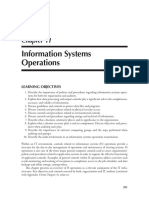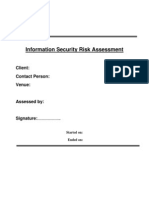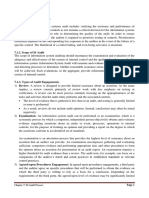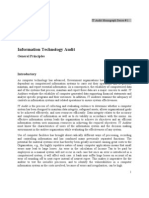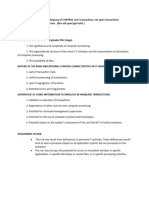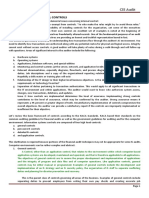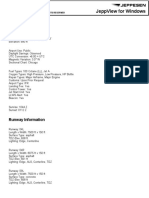Cis - Lesson 4 Part 2
Cis - Lesson 4 Part 2
Uploaded by
Terrence Grace EscobidoCopyright:
Available Formats
Cis - Lesson 4 Part 2
Cis - Lesson 4 Part 2
Uploaded by
Terrence Grace EscobidoOriginal Title
Copyright
Available Formats
Share this document
Did you find this document useful?
Is this content inappropriate?
Copyright:
Available Formats
Cis - Lesson 4 Part 2
Cis - Lesson 4 Part 2
Uploaded by
Terrence Grace EscobidoCopyright:
Available Formats
Data Center Reviews
Data center and computer operations reviews are performed to evaluate the administrative controls over data center
resources and data processing personnel (computer operations, systems analysis, and programming personnel).
The scope of the review could include:
an evaluation of the planning, staffing,
policies/procedures,
assignment of responsibilities,
budgets,
management reports,
records, and
performance measures in the following major areas of accountability: hardware management, software
management, resource protection and recovery, access controls, operations management, and
network/communications management.
A data center/computer operations audit may focus on any one of these accountabilities, or may include all of them
depending on the:
size of the data center,
operations staff, and
time budget.
For example, for a large data center with multiple computers and an extensive number of users, the data center review
may focus only on access controls and security administration.
For a small data center, the audit might include all of the accountabilities.
Objectives of data center audits are to identify
1. Audit risks in the operating environment; and,
2. The controls in place and functioning to reasonably mitigate those audit risks in accordance with the intentions of
the company’s management.
For each control objective, the auditor must
1. Evaluate control mechanisms; and,
2. Determine whether the objective has been achieved.
Pre audit preparation is required for effective data center reviews. These include meeting with IS management to
determine possible areas of concern.
At this meeting, the following information should be obtained:
Current IT organization chart
Current job descriptions for IT data center employees
List of application software supported and the hardware they reside
IT policy and procedures manual
Systems planning documentation and fiscal budget
Disaster recovery plan
Audit personnel should review the preceding information and become familiar with the way the data center provides
user services. In addition, auditors should become familiar with basic terminology and resource definition
methodology used in support of the operations environment. Engagement personnel should review the audit program and
become familiar with the areas assigned for the completion of an audit task.
Data Access Management
The following are typical audit program steps performed during a data center review.
Administration of IT Activities Audit Steps
1. Review the organization chart and evaluate the established procedures for adequacy in defining
responsibilities in the security administration area. Implement general control (provision for general
authorization over the execution of transactions, e.g., prohibiting the IT department from initiating or authorizing
transactions) and COBIT objective (position descriptions clearly and delineate both authority and responsibility).
2. Determine who is responsible for control and administration of security. Verify that adequate security exists
in the security administration function. Implement general control (prevents or detects deliberate or accidental
errors caused by improper use) and COBIT objective (information services function is in compliance with
security standards).
3. Determine whether adequate direction is maintained for each IT functional area within a policy and
procedures manual. Evaluate whether the manual is kept up to date by IT management. Implement general
control (written manuals in support of systems and procedures) and COBIT objective (operations staff have
operations manuals for all systems and processing within their responsibility).
4. Determine if written personnel policies for the IT administration personnel exist, and if these policies stress
adequate qualification and level of training and development.
5. Determine if long-range (two to five) years’ system planning is maintained by IT management and is
adequately considered in the fiscal budgeting process.
6. Assess the adequacy of inventory procurement and control pertaining to the administration of the LAN
environment. Review available inventory documentation to determine if it is adequately maintained and
complete in description and location. Compare the serial numbers on the computer software with inventory
records to determine if illegal copies of system and application software are being supported.
Operating Systems Software and Data Audit Steps
1. Determine through interviews with data center personnel whether any significant modifications or
upgrades were implemented during this audit year. Review authorization documentation to ensure that
adequate IT management approval is obtained before the implementation.
2. Determine through interviews with the IT personnel the procedures implemented to ensure that adequate
IT management approval is obtained before the implementation.
3. Evaluate access restrictions over critical system operation areas.
Computer Operations/Business Resumption Audit Steps
1. Review the IT policies and procedures manual to determine if written operating instructions adequately define
recovery procedures in the event of processing disruption, shutdown and restart procedures, procedures for
restoration of fi le server data from backups, and procedures for reporting incidents.
2. Determine through interviews with IT personnel the use of tape management software or other mechanism used to
prevent the erasure of data.
3. Determine through interviews with IT personnel the rotation of tapes used in storing backup data. Determine if
adequate off-site storage facilities are used and that tapes are rotated to the facility daily.
4. Evaluate procedures in place to control inventory of tapes maintained both on- and off-site.
5. Determine through observation the physical security of the consoles supporting backup procedures. If the console
is not adequately secure, inquire as to the mechanisms used to prevent unauthorized tampering during backup
processing.
6. Determine through the observation of computer operations facility the use of security mechanisms to provide
access to authorized personnel only.
7. Evaluate procedures in place to monitor the activities of non-computer operations personnel having access to the
operations facility. Entry of unauthorized personnel should be supervised, and a log maintained and regularly
reviewed by IT management.
8. Determine through observation the installation and maintenance of an automated fi re-suppression system, raised-
floor water sensors below floors, installation of power conditioning units, and backup power supply.
Security Administration Audit Steps
1. Determine through interviews with IT personnel if a separate security administration function has been
established.
2. Determine through interviews with IT personnel, review of IT policies and procedures manuals, and IT job
descriptions if training programs have been established for all personnel for areas such as
Organizational security policies
Disclosure of sensitive data
Access privileges to IT resources
Reporting of security incidents
Naming conventions for user passwords
3. Determine if formal policies define the organization’s information security objectives and the responsibilities of
employees with respect to the protection and disclosure of informational resources. Agreement to these policies
should be evidenced by the signature of employees.
4. Determine if procedures and responsibility for the maintenance of user IDs and access privileges in the case of
termination or transfer are defined and performed on a regular basis.
Software and Data Security Controls
Data and software security and access controls are the key controls over today’s network-oriented business systems. These
are considered operational controls in the sense that these controls function day in and day out to meet the needs of
business. The administration of the network is similar to the administration and management of any information
processing facility. In the information processing manager’s scenario, the main objective is to prevent, detect, and
correct unauthorized access to the network’s hardware, software, and data, and ensure the network’s sound operation
and the security of the corporate intellectual property and information.
Physical and Environmental Controls Management
All such controls in active use must be tested periodically. Such testing includes the evaluation of the effectiveness of
current controls and the implementation of additional controls as determined to be necessary. The results of the testing of
physical and environmental controls should be reported to senior management.
Data Access Management
The data center operations manager, the network administrator, or the corporate IT security manager, whoever assigned
this responsibility, must perform it in a very responsible manner. This person must accurately maintain user IDs and
passwords and associated file and data access schemes, as well as receive computer-generated reports of attempted
unauthorized accesses. Reports on data access and traffic analysis should be reviewed. Such reports will allow the
administrator to manage network growth and help foresee future security needs.
Policy and Procedures Documentation
The objectives here are to provide standards for preparing documentation and ensuring the maintenance of
documentation. The IT operations manager must set documentation standards so that when employees change jobs,
become ill, or leave the organization, replacement personnel can adequately perform the task of that employee. The IT
operations manager must periodically test the documentation for clarity, completeness, appropriateness, and accuracy.
Data and Software Backup Management
Backup media must be labeled, controlled, and stored in an appropriate manner. The IT manager must maintain control
logs of all backups as well as provide documentation on how to recover files, data, directories, and disks.
Other Management Controls
The internal audit department, external auditors, contingency or disaster recovery planning, personnel
background checks, and user training are included in this category. The IT auditor can aid in establishing proper testing
requirements and in reviewing, testing, and recommending the proper controls to establish the necessary safeguards.
Contingency planning and disaster recovery are essential for the proper maintenance of the network and supporting
systems. The contingency plan establishes the steps to recover from the destruction of hardware, software, and data.
Operational controls include items such as periodic personnel background checks on all employees who have access to
key organizational information directly or through support functions. The background check should involve a review of
credit history, financial health, personal problems, and other areas that may identify.
End-User Computing (EUC)
EUC groups are growing rapidly in pervasiveness and importance. The knowledge worker’s application of technology to
help business solve problems has been one of the major forces of change in business today. User dominance will prevail.
Auditors, as knowledge workers and users, can assist departments in identifying sensitive or critical PC
applications that require special attention. In organizations where controls are inadequate or nonexistent, auditors can
play a key role in developing these controls for EUC groups. Once controls are in place, auditors can review them for
adequacy and effectiveness. Auditing a EUC group can encompass the entire spectrum of IS reviews from systems
development to disaster recovery.
Auditing End-User Computing
Once it is determined that an audit of a EUC group is required, the IT auditor needs management’s agreement as to the
audit objectives, audit method, and audit scope. The audit objectives may cover specific applications, end-user support,
financial issues, or provide for strategic information to be reported to the management. Depending on the control
environment and audit objectives, the audit method will be either formal or informal. Defining the EUC group for a
particular environment will determine the audit scope of the audit.
Preliminary Audit Planning
PC applications have grown from individuals creating personal productivity tools into critical applications that are used by
the entire organization. The management may not fully realize the importance of EUC groups to the organization to
dedicate the necessary resources for a complete and thorough applications audit. However, it is essential to have the
management’s support to overcome any obstacles put forth by the EUC groups. End users tend to think of their PCs as
personal property, and they may be resentful of an intrusion by auditors. However, the end user’s cooperation can be
gained, in part, by explaining the criteria that the audit will measure. In addition, management support can be gained by
providing them with a risk analysis that identifies the exposures of EUC.
Defining the Audit Methodology
The method used to conduct the audit depends on the environment being reviewed and the agreed-upon audit objectives.
An inventory of end-user applications can be used to gain a general understanding of the EUC group. The auditor should
discuss this inventory with management to determine what type of audit should be performed. For example, a more formal
audit can be used if a specific application is being evaluated for reliance on financial information, whereas a statistical
audit that collects sample data from transactions or supporting logs can confirm end-user practices. Auditors could also
perform a quick, informal assessment by interviewing the IT staff about their impressions of the EUC group.
Defining the Scope and Content of the Audit
The scope limits the coverage of the audit to a particular department, function, or application. The content defines what
aspects of a particular area are covered. Depending on the audit objective, the content covers general controls, application
controls, hardware and software acquisition, systems development controls, change controls problem management, or
disaster recovery.
The Audit Plan
The audit plan details the objectives and the steps to fulfill those objectives. Like any audit, an audit of a EUC group
begins with a preliminary survey or analysis of the control environment by reviewing existing policies and procedures.
During the audit, these policies and procedures should be assessed for completeness and operational efficiency. The
preliminary survey or analysis should identify the organization’s position and strategy for the EUC group and the
responsibilities for managing and controlling it.
The Audit Plan
The following are the kinds of steps performed to gather the necessary evidence on which to base audit findings,
conclusions, and recommendations.
Evidence gathering. A review of any documentation that the end-users group uses
Inquiry. Conducting interviews with end users and any IT support technicians
Observation. A walk-through to become familiar with department procedures and assess physical
controls
Inventory. A physical examination of any inventoried goods or products on hand in the EUC group
Confirmation. A review of the end users’ satisfaction surveys that were handed out and completed
during the preliminary audit planning stages
Analytical procedures. A review of data gathered from statistical or financial information contained in
spreadsheets or other data files
Mechanical accuracy. A re view of the information contained in any databases used by the EUC group
through testing procedures.
Reviewing the End-User Computing Group’s Procedures and Objectives
IT should have policies or guidelines that cover EUC. These should be designed to protect company data. IT should also
have standards to ensure that end users are not using hardware or software that is not supported by them. There should be
a EUC policy that encompasses and is applicable to all EUC groups. If only departmental policies exist, each policy
should be similar to ensure continuity between departmental policies. A companywide policy should cover;
Assignment of ownership of data
User accountability
Backup procedures
Physical access controls to PCs
Appropriate documentation of all EUC groups’ applications and adequate documentation changes and
modifications
Segregation of duties
You might also like
- ITGC Audit Program Sample PDFDocument3 pagesITGC Audit Program Sample PDFSandor Molnar0% (1)
- Auditing Information Systems: Enhancing Performance of the EnterpriseFrom EverandAuditing Information Systems: Enhancing Performance of the EnterpriseNo ratings yet
- I. Company Background Profood International CorpDocument12 pagesI. Company Background Profood International CorpJulie Ann Pili100% (1)
- Narrative ReportDocument9 pagesNarrative ReportJohn Paul de Guzman100% (2)
- NUTR 150 Final Case Study Review W21Document4 pagesNUTR 150 Final Case Study Review W21Andrea CusumanoNo ratings yet
- Information Systems Auditing: The IS Audit Testing Process: Information Systems Auditing, #3From EverandInformation Systems Auditing: The IS Audit Testing Process: Information Systems Auditing, #3Rating: 1 out of 5 stars1/5 (1)
- Auditing in CIS Environment DISCUSSION16Document5 pagesAuditing in CIS Environment DISCUSSION16Yo Han SongNo ratings yet
- Vasquez AudciseDocument4 pagesVasquez AudciseJENNIROSE VASQUEZNo ratings yet
- 5 Session Five Information Technology AuditingDocument32 pages5 Session Five Information Technology AuditingISAACNo ratings yet
- Computer AuditDocument8 pagesComputer AuditReycelyn BallesterosNo ratings yet
- Test Steps For Auditing EntityDocument2 pagesTest Steps For Auditing EntityRobelia Joy VillaruzNo ratings yet
- QUESTION 1Document4 pagesQUESTION 1mcmamabolo1No ratings yet
- CH 11Document23 pagesCH 11Ar Zel ArzelNo ratings yet
- Auditing in CIS EnvironmentBIT006WFAsystemssecurityDocument28 pagesAuditing in CIS EnvironmentBIT006WFAsystemssecurityJohn David Alfred EndicoNo ratings yet
- ITG-Internal Control MatrixDocument14 pagesITG-Internal Control Matrixbladexdark67% (3)
- IT Availability and Capacity Policy and ProcedureDocument25 pagesIT Availability and Capacity Policy and Procedureislam108No ratings yet
- Types of System Audits 160864Document7 pagesTypes of System Audits 160864Prateek MalhotraNo ratings yet
- Auditing of Information Systems Case StudyDocument130 pagesAuditing of Information Systems Case StudyhjzaliNo ratings yet
- 20info Systems AuditingDocument5 pages20info Systems AuditingzelestmaryNo ratings yet
- RISK ASSESSMENT FOR IT TemplateDocument8 pagesRISK ASSESSMENT FOR IT Templatejenito215402No ratings yet
- ITGeneral Controls AuditDocument6 pagesITGeneral Controls AuditTUP BOXNo ratings yet
- Chapter 1: Introduction: 1.1 Introduction and Problem SummaryDocument20 pagesChapter 1: Introduction: 1.1 Introduction and Problem Summaryyashutank46No ratings yet
- Unit 3 Hardware AuditDocument11 pagesUnit 3 Hardware AuditScribdTranslationsNo ratings yet
- Information Security Risk Assessment ChecklistDocument7 pagesInformation Security Risk Assessment ChecklistAdil Raza SiddiquiNo ratings yet
- Topic 10 - The Impact of IT On Audit ProcessDocument34 pagesTopic 10 - The Impact of IT On Audit Process2022930579No ratings yet
- AUDCISE Unit 4 Lecture Notes 2022-2023Document32 pagesAUDCISE Unit 4 Lecture Notes 2022-2023Eijoj MaeNo ratings yet
- It AuditDocument15 pagesIt AuditaleeshatenetNo ratings yet
- Lecture 8 IT AuditingDocument6 pagesLecture 8 IT Auditingnyongesaisaiah337No ratings yet
- 03 PhysicalAccessControl and PolicyDocument16 pages03 PhysicalAccessControl and Policyalyssatimbol4No ratings yet
- M6-T1 Essay QuestionsDocument3 pagesM6-T1 Essay QuestionsAlteah CabatoNo ratings yet
- IT General Control Audit ProgramDocument20 pagesIT General Control Audit ProgramMohamad JbrNo ratings yet
- Auditing in A Cis Environment: Controls, and Substantive Testing. An IT Audit Focuses On The Computer-Based Aspects ofDocument7 pagesAuditing in A Cis Environment: Controls, and Substantive Testing. An IT Audit Focuses On The Computer-Based Aspects ofPam HerreraNo ratings yet
- Unit VIDocument10 pagesUnit VIJakkireddy Suresh ReddyNo ratings yet
- Jurnal IS - Audit - ProcessDocument4 pagesJurnal IS - Audit - ProcessLyle Walt0% (1)
- Chapter 7 Illustrative Solutions PDFDocument12 pagesChapter 7 Illustrative Solutions PDFchristoperedwin50% (2)
- Preliminary ReviewDocument6 pagesPreliminary ReviewLet it beNo ratings yet
- Chapter 7 Audit ProcessDocument14 pagesChapter 7 Audit ProcessKaranjaNo ratings yet
- Asnmnt 2 Akinuwesi 2Document5 pagesAsnmnt 2 Akinuwesi 2Atease ProductionNo ratings yet
- Chapter 10 - 1 - Operasi Sistem InformasiDocument28 pagesChapter 10 - 1 - Operasi Sistem InformasiFahrur RozziNo ratings yet
- Doc04 - ISO 27001-2013 ISMS Manual TOPDocument19 pagesDoc04 - ISO 27001-2013 ISMS Manual TOPIRIENo ratings yet
- Lesson 1Document5 pagesLesson 1Erika Mae MirandaNo ratings yet
- IT Infrastructure Audit Checklist Draft 1Document3 pagesIT Infrastructure Audit Checklist Draft 1Inder Paul GillNo ratings yet
- Chapter 7 IS Audit ProcessDocument13 pagesChapter 7 IS Audit ProcessMuriithi MurageNo ratings yet
- IT General Controls - 08Document19 pagesIT General Controls - 08Mahesh Rampalli100% (2)
- Module 11 Maintaining InfoSec 211Document57 pagesModule 11 Maintaining InfoSec 211Umair AmjadNo ratings yet
- INFORMATIONS SYSTEMS AUDIT NOTES MucheluleDocument59 pagesINFORMATIONS SYSTEMS AUDIT NOTES MuchelulevortebognuNo ratings yet
- Summary AUDITING IT GOVERNANCE CONTROLSDocument4 pagesSummary AUDITING IT GOVERNANCE CONTROLSTal AnquilianoNo ratings yet
- what are general IT controlsDocument5 pageswhat are general IT controlsreddyvariappleNo ratings yet
- Information Technology Audit: General PrinciplesDocument26 pagesInformation Technology Audit: General Principlesreema_rao_2No ratings yet
- IT Control and Audit - Appendix 8-Auditing End-User Computing GroupsDocument5 pagesIT Control and Audit - Appendix 8-Auditing End-User Computing GroupsHạ Phạm NhậtNo ratings yet
- AcquisitionDocument11 pagesAcquisitionDA DrawcordNo ratings yet
- IT Audit Basics The IS Audit Process by S. Anantha Sayana, CISA, CIADocument4 pagesIT Audit Basics The IS Audit Process by S. Anantha Sayana, CISA, CIAMaria Alexandra Campoverde PesantezNo ratings yet
- Baseline Cyber Security SOC and Resilience RequirementsDocument7 pagesBaseline Cyber Security SOC and Resilience RequirementsAshikNo ratings yet
- INFORMATIONS SYSTEMS AUDIT NOTES MucheluleDocument60 pagesINFORMATIONS SYSTEMS AUDIT NOTES MucheluleDHIVYA M SEC 2020No ratings yet
- Division of Information Technology Policy 18.2aDocument3 pagesDivision of Information Technology Policy 18.2aBara DanielNo ratings yet
- Ch07 Information Systems Auditing and ControlsDocument13 pagesCh07 Information Systems Auditing and ControlskibirighenryNo ratings yet
- ISA - Lecture 4Document28 pagesISA - Lecture 4okuhlembulaz53No ratings yet
- Notes For PPT Group 11 Audcise 1 1Document9 pagesNotes For PPT Group 11 Audcise 1 120210285No ratings yet
- Chapter 5 - Heirarchy of Ic PDFDocument7 pagesChapter 5 - Heirarchy of Ic PDFDaisy ContinenteNo ratings yet
- TYPES OF SYSTEMS AUDITSDocument15 pagesTYPES OF SYSTEMS AUDITSScribdTranslationsNo ratings yet
- Information Systems Auditing: The IS Audit Follow-up ProcessFrom EverandInformation Systems Auditing: The IS Audit Follow-up ProcessRating: 2 out of 5 stars2/5 (1)
- Information Systems Auditing: The IS Audit Study and Evaluation of Controls Process: Information Systems Auditing, #2From EverandInformation Systems Auditing: The IS Audit Study and Evaluation of Controls Process: Information Systems Auditing, #2Rating: 3 out of 5 stars3/5 (2)
- IS Auditor - Process of Auditing: Information Systems Auditor, #1From EverandIS Auditor - Process of Auditing: Information Systems Auditor, #1No ratings yet
- Jeppview For Windows: General Information General InformationDocument116 pagesJeppview For Windows: General Information General InformationLiviu 22No ratings yet
- BioPharm FinalsDocument129 pagesBioPharm Finals70116358No ratings yet
- Zavian Consultancy Mail - Ireland General Employment Work Permit ADocument3 pagesZavian Consultancy Mail - Ireland General Employment Work Permit ABabu BondsNo ratings yet
- Ashwini NakshatraDocument18 pagesAshwini NakshatraSrinivas Sukhavasi100% (2)
- Steel Fire-Rated Doors and Multi-Purpose DoorsDocument20 pagesSteel Fire-Rated Doors and Multi-Purpose DoorsJhon BantingNo ratings yet
- Dryland Agriculture in India National ProspectiveDocument7 pagesDryland Agriculture in India National ProspectiveHari KishanNo ratings yet
- Updated CLSP 6-8, IGCSE9-10, IB Year 1 Question Paper TemplateDocument7 pagesUpdated CLSP 6-8, IGCSE9-10, IB Year 1 Question Paper TemplateXIN ZHANGNo ratings yet
- User Manual V-A1.3Document15 pagesUser Manual V-A1.3Philippe RequiléNo ratings yet
- Generic MenuDocument9 pagesGeneric MenureceptionhallsNo ratings yet
- FBR New Tax SystemDocument37 pagesFBR New Tax SystemFarhan MalikNo ratings yet
- Unit 3 - 2Document10 pagesUnit 3 - 2Painted MindsNo ratings yet
- Annual-English 2023 Year 13Document15 pagesAnnual-English 2023 Year 13Mohammed ZulfikarNo ratings yet
- Acid-Base FRQ 1970-2009 WTH AnsDocument37 pagesAcid-Base FRQ 1970-2009 WTH AnsbigNo ratings yet
- Pa5000 Fullmanual 7 V2Document10 pagesPa5000 Fullmanual 7 V2Freuds Keny León CruzNo ratings yet
- LEOS - Official Newsletter of Leo District 306 A2 - September EditionDocument10 pagesLEOS - Official Newsletter of Leo District 306 A2 - September EditionIsuru SenadheeraNo ratings yet
- Surge ArrestersDocument75 pagesSurge Arrestersilyes TsNo ratings yet
- The Role of Artificial Intelligence in RadiologyDocument4 pagesThe Role of Artificial Intelligence in Radiologypublication1No ratings yet
- Actuator Selection Guide For Flow-Tek Ball ValvesDocument16 pagesActuator Selection Guide For Flow-Tek Ball ValvesArt G. Enzi100% (1)
- Succession Edexcel BiologyDocument15 pagesSuccession Edexcel BiologysomosaphiensNo ratings yet
- Equilibrium _ DPP 06 (of Lec 07)Document3 pagesEquilibrium _ DPP 06 (of Lec 07)sujalmishra6388No ratings yet
- Biology and Genetics PDFDocument8 pagesBiology and Genetics PDFPrincess Angie GonzalesNo ratings yet
- Installation Instructions Type C Boilers: Leave These Instructions With The End-UserDocument24 pagesInstallation Instructions Type C Boilers: Leave These Instructions With The End-UserCristina Ioana AhergheligiteiNo ratings yet
- The Effects of Low Level Laser Therapy LLLT On The Testis in Elevatingserum Testosterone Level in RatsDocument6 pagesThe Effects of Low Level Laser Therapy LLLT On The Testis in Elevatingserum Testosterone Level in RatsJack WardenNo ratings yet
- F5 Chem Rusting ExperimentDocument9 pagesF5 Chem Rusting ExperimentPrashanthini Janardanan100% (1)
- Changes in Peripheral Blood Leukocyte Percentages and Function of Neutrophils in Stressed Channel CatfishDocument8 pagesChanges in Peripheral Blood Leukocyte Percentages and Function of Neutrophils in Stressed Channel CatfishCecilia Almazan SanchezNo ratings yet
- Lavadora LG Manual de ServicioDocument43 pagesLavadora LG Manual de Serviciolester1968No ratings yet
- CNY17 1 CTMicroDocument14 pagesCNY17 1 CTMicropedrojdfadslfjlsklswNo ratings yet












